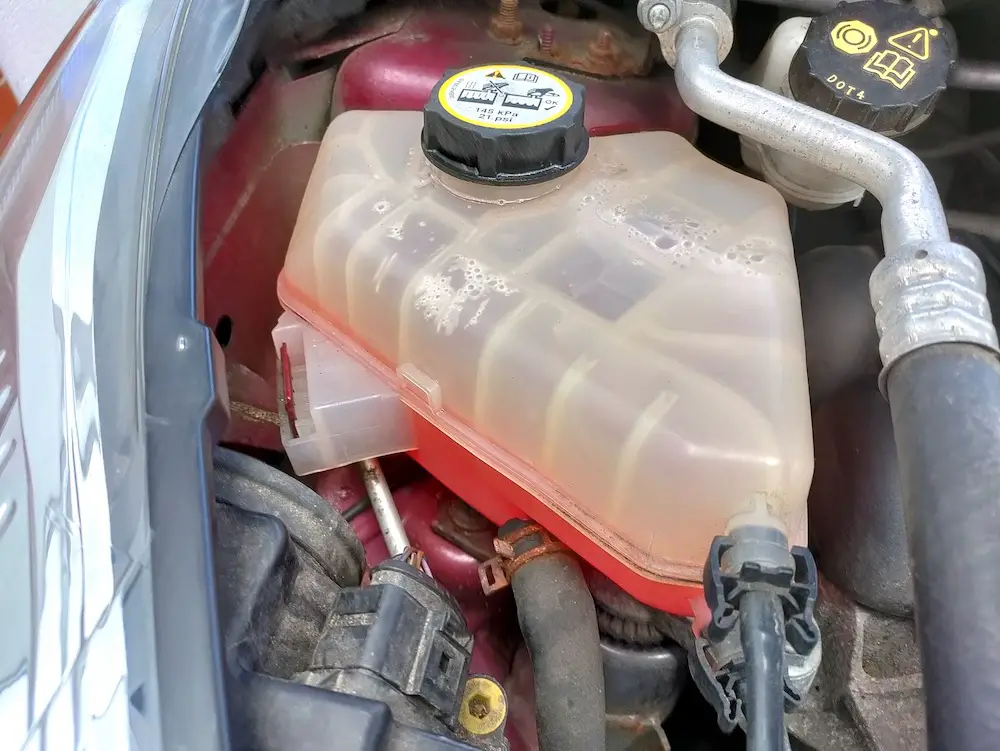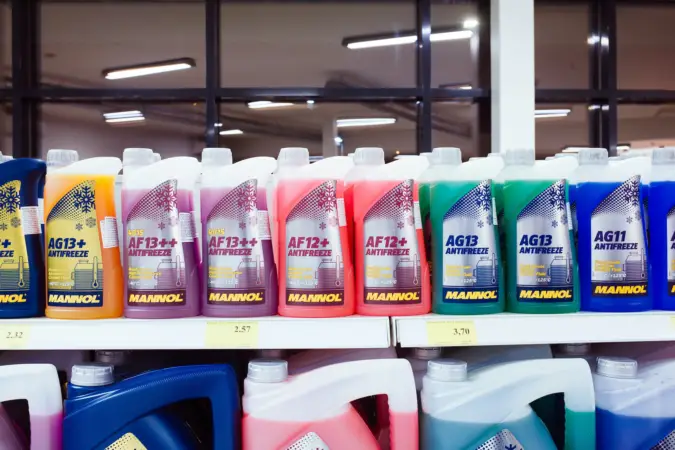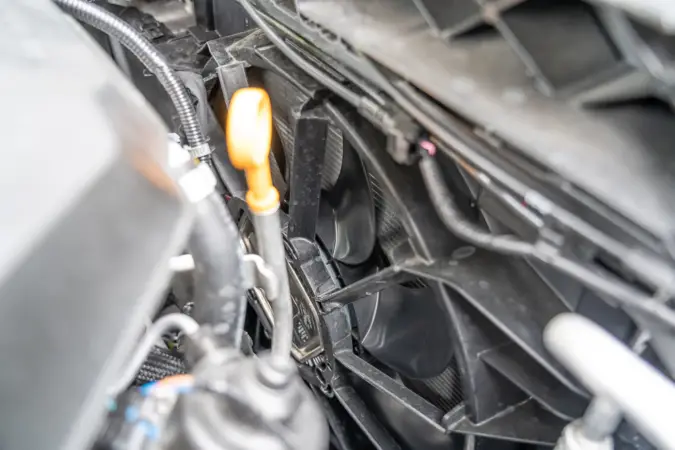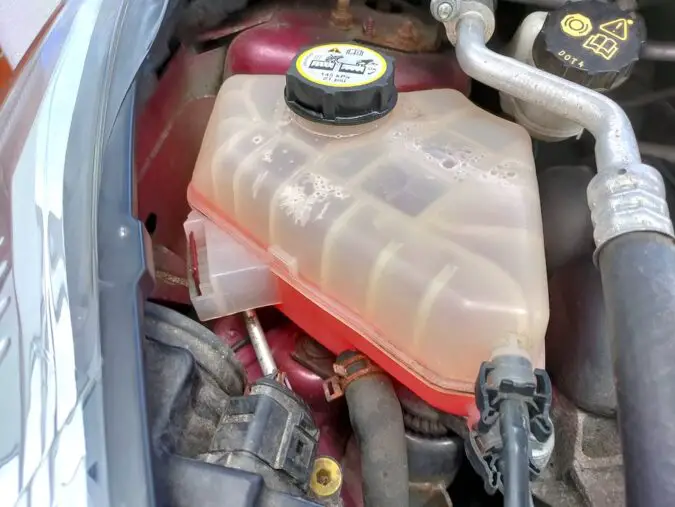As gearheads, we all know how important it is to keep the engines from overheating. An engine that is too hot is never a good sign, and it can cost you thousands of dollars in repair bills. One of the best ways to prevent your engine from overheating is by keeping it topped up with the correct amount of coolant. But, how can you tell when the coolant level is low? We will answer that exact question in this article by telling you about some of the most common low coolant symptoms.
Under normal conditions, an engine heats up to about 220℉. Engine coolant is responsible for removing this heat, preventing it from damaging critical engine components. But, to understand what coolant is and how it works, you should have a clear idea about the cooling system of a vehicle. So, let’s start off from there. Follow us along to learn all about the cooling system of your car.
Engine Cooling System
Much like the fuel system and the electronics, the cooling system is also essential for a vehicle to function as intended. As the name suggests, the main function of the cooling system is removing excess heat from the engine that is produced as a result of the internal combustion process.
Generally, there are two main types of cooling systems. First up are air-cooled engines. They have fins around the surface and rely on the cold air of the atmosphere to remove heat.
Owners of these engines don’t have to worry about low coolant symptoms, as these engines do not make use of the fluid. Early Porsche models used air-cooled engines, but have since moved to fluid-cooled systems since the dawn of the new millennium.
On the other hand, fluid-cooling systems are used by almost all modern vehicles to extract excess heat from their engines. Not only are these systems more effective at cooling the engine, but they are more efficient as well. In these cooling systems, coolant runs through various fluid channels around the engine, absorbing the heat from the engine block.
A number of components have to work in harmony in order to effectively cool down an engine. These parts include,
- Radiator
- Water Pump
- Overflow Tank
- Thermostat
- Temperature Sensor
- Heater Core
- Cooling Fan
- Head Gasket
- Hoses
Before looking into low coolant symptoms, let’s take a look at these crucial elements of the cooling system.
1. Radiator
The radiator is one of the most important elements of the cooling system. Typically made using aluminum, its main function is to transfer the heat from the coolant to the outside air. To do this, the radiator consists of many tubes and fins. Other notable parts of the radiator include the drain plug, inlet port, and outlet port.
2. Water Pump
The water pump is arguably the most important piece of the engine cooling system. A radial impeller connected to the engine powers the pump, and it sends the coolant through the various components of the cooling system.
3. Overflow Tank
The coolant overflow tank is made out of plastic and it is located near the radiator. It is connected to the radiator via the inlet port. Before setting off on a drive, you should make sure to fill the overflow tank to the appropriate level with coolant to make sure the cooling system functions properly.
4. Thermostat
It is important to let the engine warm up to its operating temperature before sending coolant out to the radiator. This is done using the thermostat, which has a valve that only opens when the coolant is ready to flow to the radiator.
Here’s a fun fact for our readers. Did you know that an engine thermostat contains paraffin wax? Automakers use this material as it expands and contracts at certain temperatures, making it a great fit for thermostats.
5. Temperature Sensor
Modern vehicles use hundreds of sensors to monitor all types of data, including engine and coolant temperature. The speed of the engine cooling fan is determined according to these temperature readings.
Additionally, the coolant temperature sensor feeds data to the vehicle’s temperature gauge, which you can spot on the dashboard. Coolant temperature sensor readings affect engine performance as well. This is due to the fact that these readings are being used to control the engine ignition timing and the fuel injection rate.
6. Heater Core
Two rubber hoses connect the heater core to the engine cooling system. Hot coolant flows to the heater core through the first line. Then, the heater core transfers some of that heat to the interior of the car, cooling the fluid in the process. Later, the second rubber line delivers this coolant back to the engine top.
7. Cooling Fan
You can easily spot the radiator cooling fans when you open the hood of your vehicle. The exact number of cooling fans may vary depending on the make and model.
When a vehicle slows down or comes to a stop, the amount of air flowing through the radiator gets reduced. This can impact the performance of the cooling system, causing the vehicle to overheat. This is when the cooling fan kicks in. It keeps the radiator cooled down until the vehicle starts moving again.
8. Head Gasket
Being a gearhead, you already know that water should never enter the combustion chamber. On top of affecting the performance, water can cause catastrophic engine damage as well. Every engine comes with a head gasket which ensures that the engine block and cylinder heads are properly sealed.
9. Hoses
The final component of the cooling system we will be discussing with you is the hoses. When taken as a whole, an engine cooling system uses dozens of hoses to connect various components like the radiator, heater core, and engine with each other. Modern engine cooling systems use hoses made out of rubber material.
Now you should have a good understanding of the different parts of a vehicle cooling system. This knowledge will come in handy when we are discussing low coolant symptoms later on in this article.
What Is Coolant
Engine coolant is a liquid with an ethylene glycol base. You can spot coolants with different shades of pink, green, and orange out on the market. No matter which color of coolant you use, the main function of the liquid remains the same, which is regulating the engine temperature to prevent it from overheating.
You can spot three types of coolant out on the market. They are,
- Inorganic Acid Technology Coolant
- Organic Acid Technology Coolant
- Hybrid Organic Acid Technology Coolant
No matter which type you go for (but ideally, you should just re-use the same one that came with your car), it is important to keep an adequate amount of coolant inside the engine at all times. Failing to do so will result in your engine overheating and significant repair bills.
Low Coolant Light
The “low coolant” warning light on the dashboard turning on is one of the most obvious low coolant symptoms you may come across. As soon as you spot this symbol, your first course of action should be to stop the vehicle in a safe manner as soon as possible. This will prevent the engine from getting damaged due to overheating.
After coming to a stop, turn off the engine and let it cool down for at least half an hour.
Following this step is important, as opening the coolant reservoir when the fluid is hot has the risk of releasing hot and pressurized steam which can cause severe burns.
When the engine has adequately cooled down, you can go ahead and open the reservoir cap. This will release any built-up pressure, and allow you to top up the coolant once again to the recommended level. Also, take the time to check for any signs of coolant leaks. If you spot any, take the vehicle to a mechanic to get the issue sorted before it causes any major damage.
Coolant Level Low
Ignoring low coolant symptoms and continuing to drive the vehicle when the coolant level is low can have severe consequences. Some issues you can expect to come across by doing so are,
- Engine Overheating
- Blown Head Gaskets
- Engine Block Damage
- Air Entering The Cooling System
- Seized Engine
1. Engine Overheating
The most obvious consequence of running an engine with inadequate coolant is overheating. When there is not enough coolant, the water pump can’t pump the liquid through the cooling system. This causes the engine to get too hot, damaging various components within it.
2. Blown Head Gaskets
Engines that are frequently running on low coolant levels have the risk of blowing their head gaskets. As we mentioned earlier, the head gasket resides between the engine block and cylinder heads. In order to replace it, mechanics have to take the whole engine apart. As you might have guessed the repair cost will be astronomical, often exceeding $1000.
3. Engine Block Damage
When an engine runs with a low coolant level, it creates hotspots throughout the system. The extreme temperatures of these hotspots can sometimes cause the engine block to crack, which is not a thing you want to see. There is no way to fix a cracked engine block. Instead, you’ll have to replace it with a whole new one.
4. Air Entering The Cooling System
If there isn’t enough coolant, the water pump car can end up pumping air into the cooling system. This results in the formation of airlocks inside the system that disturb the flow of the remaining coolant, causing the engine to overheat in the process.
5. Seized Engine
A seized engine is often the worst outcome of driving your vehicle while it is low on coolant. When an engine can’t disperse its excess heat, the metal parts inside it can expand too much, causing catastrophic damage. When faced with a seized engine, you’ll have to tear it apart in order to pinpoint the area that is causing the issue.
The best way to avoid all these expensive repairs is to keep an eye on the coolant level while you are on the road. Next up, we will tell you about some low coolant symptoms that will help you detect this issue before it gets out of control.
Symptoms Of Low Coolant
As we have already established, having low coolant in your engine is just waiting for disaster. But, mistakes happen, and you can simply forget to top up the coolant. That is where knowing about low coolant symptoms comes in handy. Some indications of an engine that is running low on coolant include,
- Temperature Gauge Readings
- Anti-Freeze Smell
- Poor Fuel Economy
- AC Blowing Hot Air
- Automatic Engine Cut Off
- Faulty Heater
Low Coolant Symptoms #1 – Temperature Gauge Readings
The temperature gauge on the dashboard indicates the readings from the temperature sensor located within the engine. Under normal operating conditions, the indicator should be below the halfway mark. But if you spot the temperature gauge readings rising up unnaturally, there may be an issue with the cooling system.
Furthermore, if the temperature gauge reading exceeds 200 ℉, you should immediately shut off the engine to prevent it from overheating.
Low Coolant Symptoms #2 – Anti-Freeze Smell
Coolant, also called anti-freeze, has a distinct sweet smell as it contains glycol. If you smell this odor from inside the passenger compartment or under the hood, the chances of your vehicle having a coolant leak are extremely high. If you come across this symptom, we advise taking your vehicle to a qualified mechanic and letting them have a look at it.
Low Coolant Symptoms #3 – Poor Fuel Economy
Low coolant levels cause the engine to run hotter, requiring the water pump to work extra hard in return. On top of putting more strain on the water pump, this increases the power consumption as well. As the engine has to work harder to produce more power, you might detect a reduction in your vehicle’s average fuel economy.
Low Coolant Symptoms #4 – AC Blowing Hot Air
Inadequate coolant levels have an effect on the climate control system of vehicles as well. The AC uses the thermostat to control the cabin temperature. But, when an engine is overheating, the thermostat can develop faults. As a result, the AC may end up blowing hot air into the interior instead of the cool breeze that passengers expect.
Low Coolant Symptoms #5 – Automatic Engine Cut Off
Sometimes, the high temperature of an engine caused by low coolant can cause a vehicle to shut off automatically. This feature is present in some vehicles and has been designed with the intention of shutting the engine down to prevent damage from the excess heat.
Once the engine shuts down in this manner, you may have trouble starting it back up as well. Ultimately, if you experience random engine cut-offs, checking the coolant level might be a good place to start.
Low Coolant Symptoms #6 – Faulty Heater
If you detect that the heater isn’t working as intended, low coolant levels might be the culprit behind it. You see, the heater utilizes the engine coolant to work as intended.
So, when the coolant levels run low, airlocks form inside the heater core, hampering the heating process. If no heated air is coming out of the heater, the engine may be dangerously low on coolant.
Coolant Light On But Not Overheating
Inside the engine, there is a coolant level sensor. It measures the level of coolant in the engine and sends a signal to the ECU when it is too low. Sometimes this sensor can malfunction, sending false readings and causing the coolant light to turn on. As there is enough coolant in the system, the engine won’t overheat in this situation.
However, our recommendation for you is to always check for leaks if the low coolant warning light has turned on in the dashboard. One of the easiest ways to identify whether your vehicle has a coolant leak is by checking under the vehicle. If you spot any orange, red, or green fluid on the ground, the chances of your vehicle suffering from a coolant leak are highly likely.
Several factors can lead to coolant leaking from your vehicle. Some common causes include,
- External Leaks
- Head Gasket Issues
- Faulty Intake Manifold Gasket
- Broken Radiator Cap
Low Coolant Symptoms, Common Causes #1 – External Leaks
External leaks are the most common cause of low engine coolant levels. These can happen at any part of the vehicle cooling system. Luckily, these leaks can be easily spotted if you look closely, and aren’t that expensive to fix. The water pump, thermostat, and radiator are some parts of the cooling system that are well known to easily develop external leaks.
Low Coolant Symptoms, Common Causes #2 – Head Gasket Issues
We already talked about the importance of the head gasket to an engine. A blown head gasket allows coolant to seep in and mix with the fuel, causing the engine to combust it.
The easiest method to recognize a blown head gasket is by looking at the exhaust. If you notice white smoke, the chances of your engine suffering from a head gasket issue are high.
Low Coolant Symptoms, Common Causes #3 – Faulty Intake Manifold Gasket
Some vehicles have a cold air intake system that cools the incoming air for extra performance. As a result, there are coolant channels inside them. The intake manifold gasket is a crucial element of this system. If this gasket develops a leak, there is the risk of coolant being sucked into the engine, resulting in white smoke.
Low Coolant Symptoms, Common Causes #4 – Broken Radiator Cap
The radiator cap contains an overpressure valve on the inside that makes it rise when the pressure levels inside the radiator are too high. But, if that valve becomes faulty, the cap will open before that pressure limit allowing the coolant to flow out. White smoke coming from the engine bay is the first indication of a faulty radiator cap.
All these problems can cause the low coolant light to turn on without the engine overheating. So, as a vehicle owner, it is important for you to be aware of these risks at all times.
Conclusion For Low Coolant Symptoms
Coolant is essential for an engine to run properly, and there are many symptoms that you can use as warning signs before low coolant levels cause severe damage to the engine.
The AC blowing hot air, the heater not working properly, the low coolant warning light coming on as well as the engine automatically shutting down are some low coolant symptoms you may come across.
Failing to fix these issues and continuing to run the vehicle will destroy your engine, requiring extensive repairs to get your vehicle back up and running. So, we recommend keeping a close eye on your engine coolant level at all times.
FAQs On Low Coolant Symptoms
What Does Coolant Do
Coolant is an essential part of the engine cooling system. It transfers heat away from the engine, increasing its longevity and performance. When the coolant level is too low, an engine can overheat and cause all sorts of issues like blown head gaskets, and block damage.
What Is Antifreeze Used For
The main use of antifreeze is regulating engine temperature during extreme weather conditions. It contains glycol, which gives the liquid a sweet smell. Antifreeze should be used in a 50/50 mixture with regular water in order to get the best performance out of it.
What Coolant Does My Car Need
There are several types of coolants on the market. Some of the most popular ones are Inorganic Additive Technology (IAT), Organic Acid Technology (OAT), and Hybrid Organic Acid Technology (HOAT). Additionally, you can find different colored coolants for sale too. The best way to find the type of coolant recommended by your car’s manufacturer is by referring to the owner’s manual.
Does The Car Need To Be Running When Adding Coolant
Adding coolant when the engine is running is not recommended. Instead, the coolant should be added when the engine is cold. Additionally, make sure to put the vehicle in park or neutral, and pull the parking brake before adding coolant. Once you are done, wait a few minutes before starting the vehicle.
How To Check Radiator Fluid
The best way to check the radiator fluid level is by opening the cap of the reservoir and looking into it. However, make sure that the engine is cold before doing so.





